CUBE TUBE
A new way to watch & display the videos I publish online. I took the class 100 days of making 2nd semester of last year. I made 100 video in 100 days – I have always wanted to make an interesting platform to host them on. I want to include some behaviors to give the videos a sense of life outside of my control. As if, when I upload them, they group together an become part of an extended family, outside of my control.
Visual Documentation:
Star Catcher: A Post-Mortem Pathways Study
Star Catcher: A Post-Mortem Pathways Study
The pathways we saw
1.The pathways
a) Lots of arm waving. Linear, circular, repeating or randomness.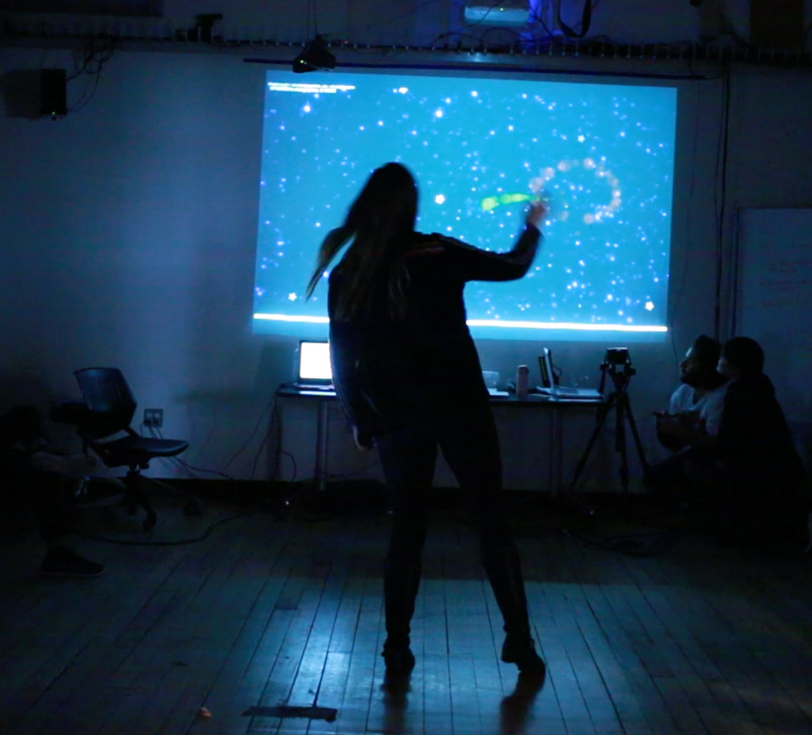
b) Linear and noise pathways using all X, Y, Z. The players move horizontally, back and forward towards the screen, squat and standing up vertically.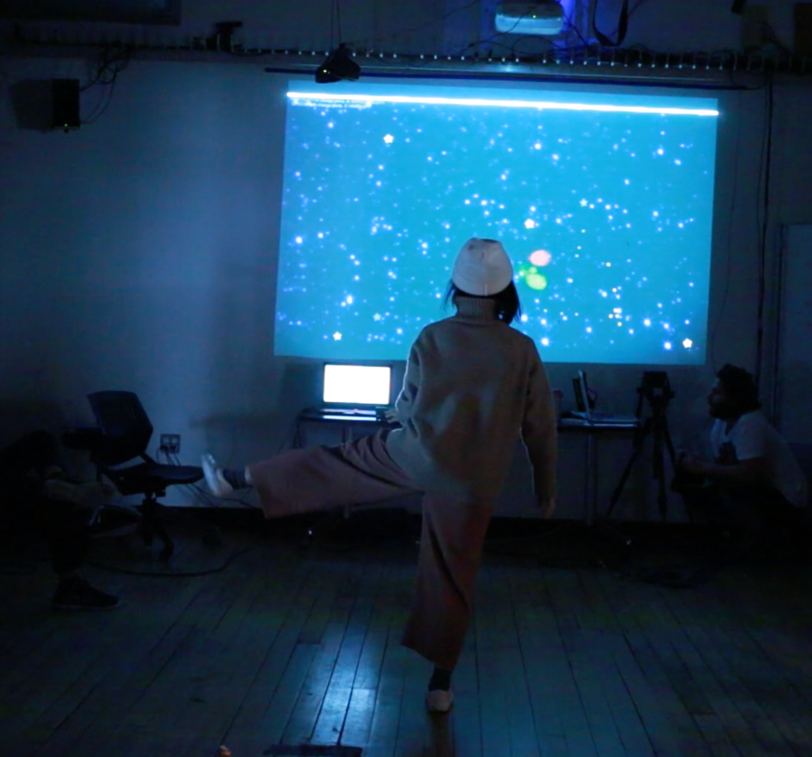
c) Some stretching.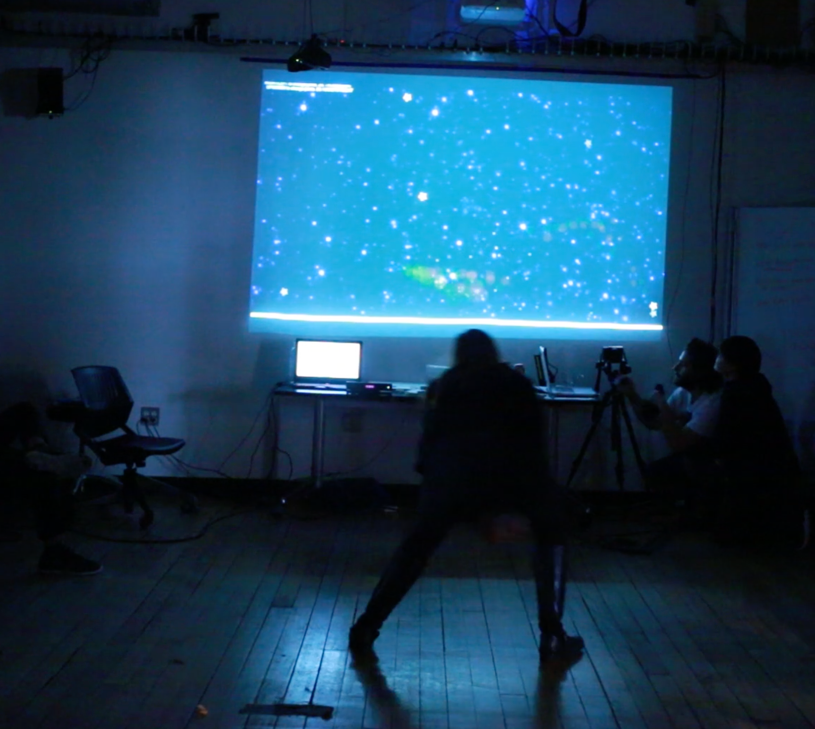
d) Circular movement turning their body.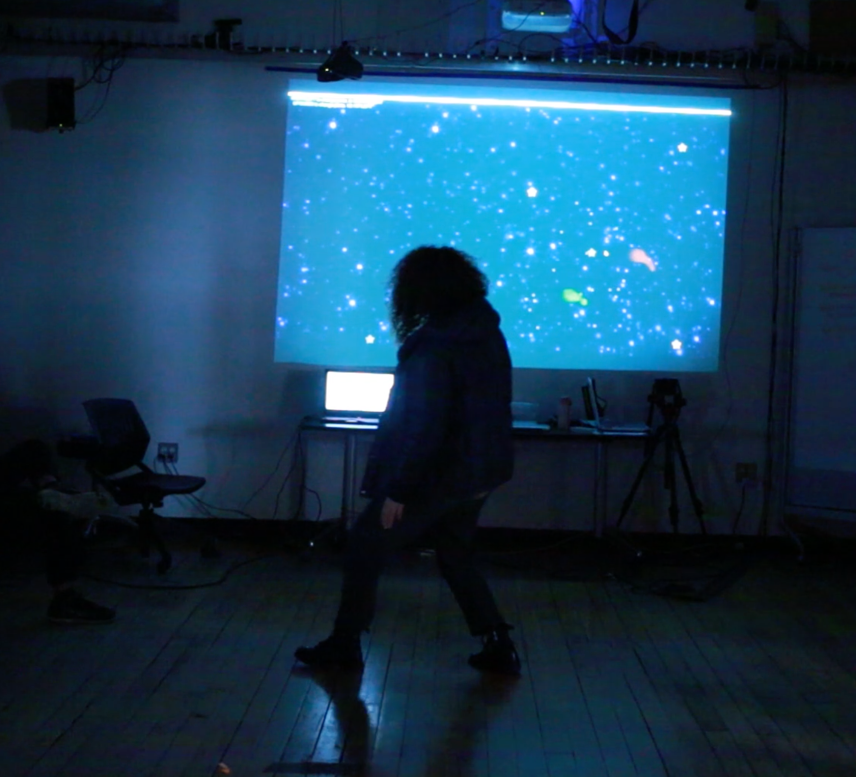
What did we predict and design for?
a) Arm waving and position adjusting. One of the core interaction is to find out which joints are selected and get to control them.
b) Linear movement that parallel to the screen.
Which were surprises?
a) Usage of depth space. We did design for depth space, but our expectation was in another way: For example, player need to reach two stars at the bottom of the screen, but using two joints from top part of his body. Then he’ll need to move backward so that it could be a little bit easier.
b) Player trying to draw with their joints. Ehh, this is not our intention. The reason could be the trail taking too much attention.
c) Player trying to side face the screen. We thought it would be mostly facing the screen.
Design choices
1.The core interaction
The core interaction is to reach two stars at the same time to ‘Catch’ them and score. Players need to figure out which two joints of theirs are selected by looking at the skeleton. And adjust their pose and even position in the room to get the two joints reach the stars.
2.The pathway we expect
Our design intention was to require some body stretches and all kinds of combination of poses based on stretches for the players. The random generating stars and random selected joints brings a bit difficulty to this interaction. It’s impossible to achieve the goals if the player is standing still. We want the players to use some joints that they don’t normally move with intention, such as shoulder and hip. This is the kind of pathway we expected.
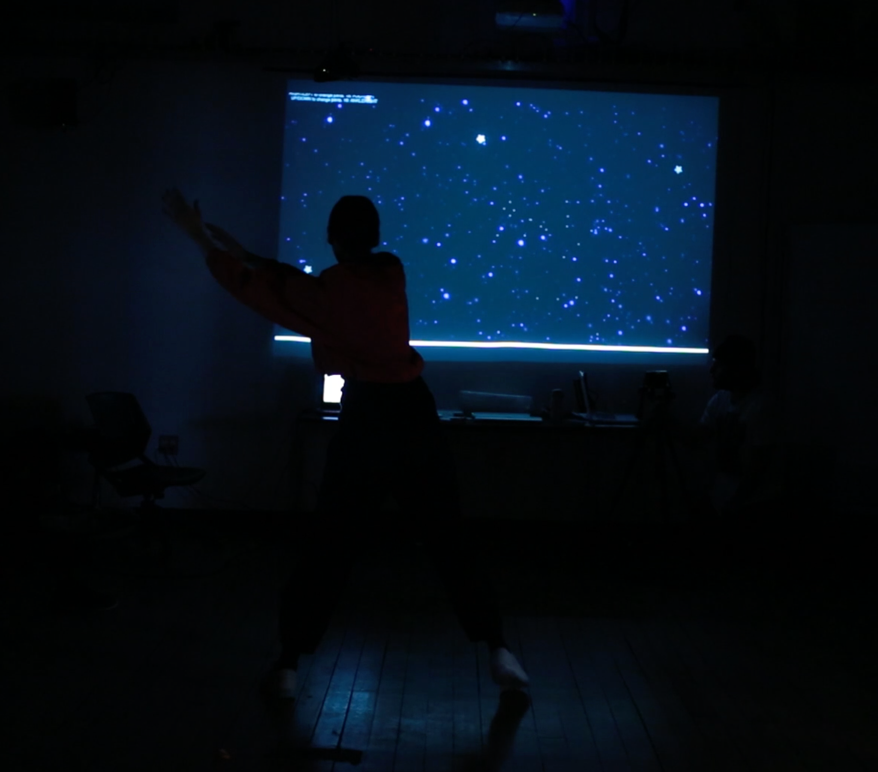
3.The visual elements
1)Color trail of joints with fade-in effect. –code done by Corbin
2)Rotating and blinking stars generate randomly from the edge. – code done by Manning
3)Star disappear with intersection check. – code done by Yuhan
4)Beautiful animated background galaxy. – code done by Corbin
We all love this ‘Star Catcher’ idea so much. We wanted the experience to be complete and immersive— not make the audience feel it’s just an everyday P5 sketch using one joint as x and y. But the way we put everything together is more like an experimental phase that we just put all the parts that we achieved technically and individually together. And we don’t criticize on teammates’ work. As a result, the outcome that we didn’t thought through was not as good as we expected. Unfortunately, the visual elements and the technical elements were not meshed well together. We did not think about how the visual dynamics would direct the technical aspect of our sketch. This is valuable information to receive, as we will now design to make sure the visual elements enhance the the players ability to discover their agency within Star Catcher.
There was a discussion on how we could leverage the Trails that we incorporated into Star Catcher. If we need slower motion from the user, the audience suggested that would be the moment to use a longer, slower dissipating trail, whereas if we need a fast, rapid movement, change the trails to a shorter duration. This could be useful in directing the player through different types of exercises
How the audience felt
The overall experience seems to be very confusing to the audience, as we were the one group that got a lot of questions. All those visual elements we put there made it hard for the audience to understand the interaction very clearly. The feedback we got was mostly about ‘What’ and ‘How’ other than ‘Why’.
1.No one found the stars could be interacted with until the third tester. Even after the third tester found it, the following testers seem not clear about this function. And there’s no feedback when the player reaches one of the stars other than disappear, that made it not clear to the audience.
2.Audience felt the trail could be the interaction itself because it’s obvious and not continuous. They thought it was something to play with and change with different movement.
3.The red/green color are confusing. They didn’t know what does each means. And it doesn’t work for color blind audience.
4.Audience were curious about the visual design and how we made them. They seem like the way it looks.
5.The players realized that the chosen points were not only hands. But the audience that watched it didn’t realize. They felt the skeleton is not very clear to recognize
6.It was clear that the audience/player wanted a clear symbiosis of the visuals and sound. This would generally relate to action/reaction – i.e. when the player collects or catches the stars, there must be a sound response with a visual response to corroborate the interaction.
7.The players all suggested that the music should drive the movement.
8.Our audience and players found the idea of “being apart of the space” fascinating. How can we incorporate the player into the space? Clearly the visuals were working to ignite the imagination of our testers, perhaps if we enhance the dimensional space by projecting onto the floor, onto the ceiling, StarCatcher will be a more immersive experience.
9.We had feedback from our crit that suggested the idea of “Not giving too much away.” Our testers suggested to us that holding back on instruction could allow for a fun puzzle element.
Before vs. After diagram
Before

After
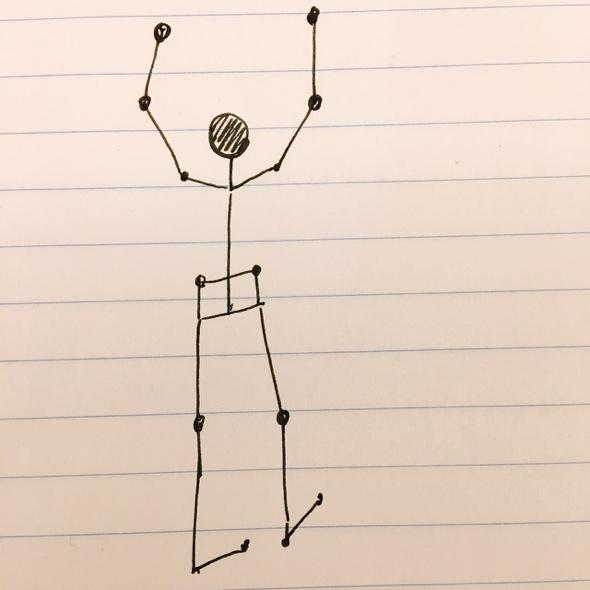
Diagram with additional color referencing. This idea came up during production and may in fact be very useful for helping our users understand cause and effect/relationship to environment

THESIS WEEK 2 ROUNDUP: RESEARCH AND READING: B.A.N. – BROOKLYN BOTANICAL GARDENS – I.C.E. FREE NYC – BEN MOSKOWITZ – NARI WARD
 Nari Ward’s We The People
Nari Ward’s We The People
Week 2 Roundup
Research:
I met with a member of the Brooklyn Anti Gentrification Network, which is described as “a mass-based coalition of tenants, homeowners, block associations, anti-police brutality groups, legal and grassroots organizations working to end the rampant gentrification and displacement of low to middle income residents of Brooklyn, New York.” My contact showed my around her neighborhood of Prospect Lefferts Gardens as we walked towards the Brooklyn Botanical Gardens. The point of our trip was to examine an upcoming proposition made by real estate developers to erect new condos between the Vanderbilt and Washington Ave triangle. To accomplish this, the developers will need to apply for Spot Rezoning which is applying new zoning to a specific piece of land within a larger zoned area when the rezoning is usually at odds with current zoning restrictions. I came armed with my camera as I was asked to make some renderings of the proposition. These were designed to give and idea of how the neighborhood might change. I also found this useful in imagine how my proposed environment could look and feel.

With property taxes already boiling over across most, if not all of Brooklyn, the proposition of an influx of 20,000 people into my contacts neighborhood is a frightening proposition.
Later in the week I attended a rally/ press conference in front of the Municipal Court Houses to support ICE FREE NYC. Their current efforts are to “educate the public and public officials about the current environment and share stories about how New Yorkers are affected by our city’s collaboration with ICE which is shattering lives, families and communities through racial profiling, detention and deportation.” This rally gave me further understanding into how neighborhood hyper development endangers the lives of all immigrants, legal or illegal, and their families. I plan to incorporate information and statistic collected by ICE FREE NYC into the algorithms and software design of the changing environment
Next, I met with Ben Moskowitz, who leads development for R&D and innovation at the International Rescue Committee as well as being a ITP adjunct professor. I sought him out as he has a keen eye for interesting and innovating ways of expressing ideas regarding societal issues. We brainstormed together about the immersive environment that I am going to create and created some key factors that we believe should be incorporated:
- The amount of people should directly influence the environment itself. For example, the more people who enter the room, the more expensive it will become to enter the environment. On the flipside, something like the artificial “Police Presence” would increase.
- Price VS. Experience Vs. Incentive must be at the heart of the exhibition. Will less people come when the entrance becomes $0.50 cents as opposed to $0.05 cents? With increased prices, will the show become less desirable?
- There must be an incentive to come to the show, but with that incentive there must be real consequence in relation to your presence.
- Economics must play a role in how the environment changes, as well the images that are projected.
Reading:
Naked City: The Death and Life of Authentic Urban Places by Sharon Zukin:
A great rundown of urban change and the societal factors that caused them from 19th century to present day New York City.
T.A.Z.: The Temporary Autonomous Zone – Hakim Bey
A seminal piece of artist/anarchy text
Sun Splashed – Nari Ward http://pamm.org/exhibitions/nari-ward-sun-splashed
Nari Ward’s incredible installation pieces speak with a mix of critique, darkness, optimism, and joy. This inspires me as he believes the true way to reach people is through appealing to the most import force within our humanity, the seeking of happiness.
I intend to reach out to him.
THESIS ASSIGNMENT 1 – DREAM REVIEW: DECONSTRUCTING THE FUTURE OF GENTRIFICATION, ONE PROJECTION AT A TIME.
Deconstructing the future of gentrification, one projection at a time.
Corbin Ordel’s latest project A Future Sculpture of America (FSOA) is an experiment in artistic rendering one must see to understand. Situated on the 33rd floor of the Chase Manhattan building, Ordel uses the non-traditional location of the exhibition to explore themes of gentrification, community politics, art politics, inner city migration, and technology. Machine learning and projection mapping aid in transforming the carefully designed exhibition space into easily recognizable New York Cityneighborhoods, street corners, and landmarks. However, although recognizably New York, what is different about the cityscapes is that they have been stylistically and architecturally influenced by something non-human, something machine like. You can plainly see that areas of New York City yet to be transformed by hyper-development and spot rezoning are re-imagined under a set of ever changing parameters. Projected text informs us of what perimeters (White Wash, Whole Foods, Increased Police Presence, Art Gallery, New York State Housing Finance Agency 80/20, Airbnb, Luxury Hotel, to name a few) are being used by the A.I. algorithm to produce these futuristic, dystopian, and if not uncomfortably truly recognizable imagined city streets. If you have ever experienced Google’s Deep Dream, which, according to Google, “is a platform where you can transform photos using a powerful AI algorithms,” you know how disconcerting these images can be. To this end, it is not surprising that when our projected environment, in one case, a low income neighborhood in the Bronx is transformed into a series of big box stores and glass towers, and in another, a block of the Upper West Side melts into a luxury shopping mall, the imagery is palpably uncomfortable. The intent of show is clear in its message, that gentrification will eventually affect all of us living here in New York and that if we don’t begin thinking about our impact on the neighborhoods we live and play within, they may be gone before we ever stepped up to fight for their existence.
Manifesto: Interactive Music
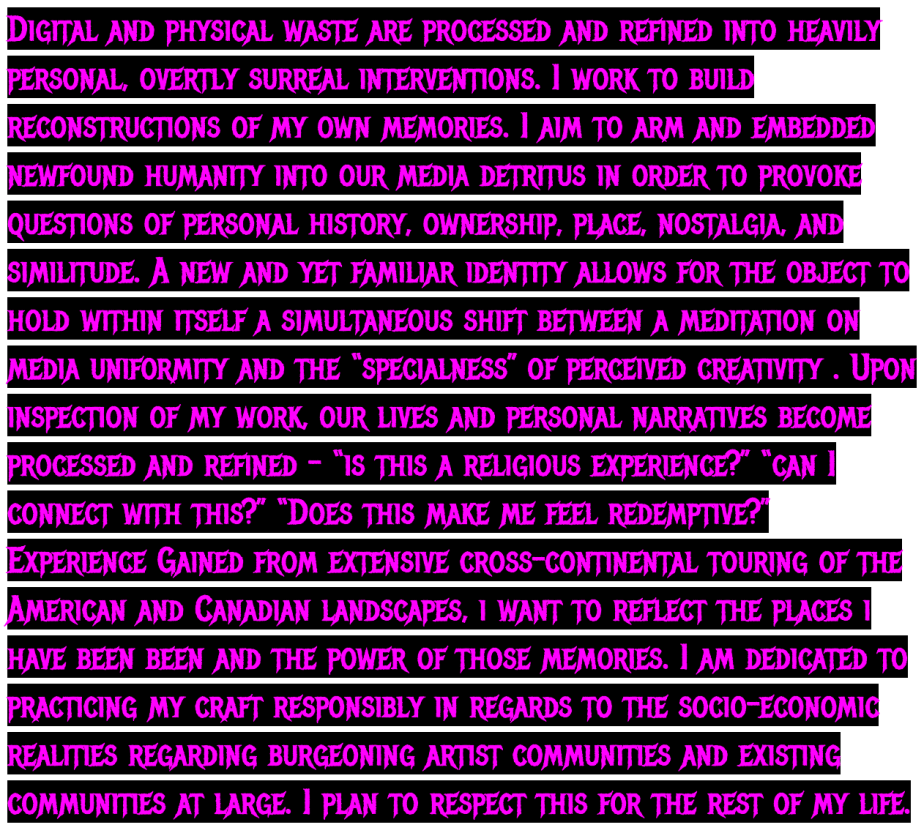
Digital and physical waste are processed and refined into heavily personal, overtly surreal interventions. I work to build reconstructions of my own memories. I aim to arm and embedded newfound humanity into our media detritus in order to provoke questions of personal history, ownership, place, nostalgia, and similitude. A new and yet familiar identity allows for the object to hold within itself a simultaneous shift between a meditation on media uniformity and the “specialness” of perceived creativity . Upon inspection of my work, our lives and personal narratives become processed and refined – “is this a religious experience?” “can I connect with this?” “Does this make me feel redemptive?”
Experience Gained from extensive cross-continental touring of the American and Canadian landscapes, i want to reflect the places i have been been and the power of those memories. I am dedicated to practicing my craft responsibly in regards to the socio-economic realities regarding burgeoning artist communities and existing communities at large. I plan to respect this for the rest of my life.
Digital Image Reset
http://www.itpcoffeecam.space/
ITP COFFEE CAM
Curious if there is coffee being brewed on the floor?
Use this convenient stream to check on the status of your javus
Hacking Story Frameworks: Final Project Discussion
Present your group’s chosen project (1) Frame the problem (WHY), (2) What’s the story / idea (3) Inspiration / References (4) Next steps
For my final project I am working with Zoe Bachman. We are continuing my mid term project, the open world art game”Heist,” A free roaming art game intended for users to discover the nefarious and secretive practices of consumer banks that directly contribute to gun violence in New York City.
“The information is public,” was the most context changing moment of my conversation with Anna Brower, who is may contact at the Office of The Public Advocate of New York City. Bloomberg, the privately held financial software, data, and media company publishes TD Bank’s dealings with weapons manufacturers. I very quickly started to ask why then, if this information is so readily available for us, is this conversation taking up so little of our attention? In our current state of content aggregators and social media feeds delivering our news, we see relevant, ongoing, and topical environmental and social issues begin to trend upwards and outwards.
We have seen in the last many months solidarity with Standing Rock and the NO DAPL movement, and even in the last few days thousands of people checking in on Facebook to help the Water Protectors. This past summer we saw solidarity for BLM in the form of boots on the ground protest and huge amounts of support shown by social media users. After Pulse Nightclub, there was an incredible outpouring of support for the victims, but the underlying issue of gun control, which was in fact talked about after the event, has faded into the background, barring some longer lasting outcomes.
So, I must ask, how can an ongoing problem with such an ingrained sense of presence in American life be tackled, without having to rely on one seminal event to gain the type of solidarity movement we have seen brought forth for other issues revolving around social justice issues?*
I do have an answer, or at least, a tactic I believe can make a difference: Spread the information which is actively being hidden in plain sight.
If we want to stop the cyclical relationship between banks, weapons manufacturers and inner city gun violence, It is imperative to get this information spread to the public. By doing this, we can put pressure on the forces that keep the gears of this systemic problem turning.
To quote my midterm:
“I absolutely believe that after learning this information an incredibly large amount of people will want to distance themselves from this system. Having conducted research within ITP and my social network, the financial backing of weapons manufactures by consumer banks is very often surprising and upsetting information to learn, as well as being in complete opposition of many, if not most people’s ideals.”
My vision:
To create an intimate and immersive story for a wide audience that details the true impact and relationship between six financial institutions and the weapons manufacturers they finance. By doing this in an immersive 3D environment, I can imitate real neighborhood in New York where real protesting has been occurring. I believe this will work to engage people within the stories being told, as through experiencing the world where these events take place (protests, actual instances of gun violence, displacement, police harassment), they will come to understand that their own seemingly innocuous actions have a true impact, not only the city as whole, but potentially their own neighborhood.
References & Inspirations:
When talking with Zoe, I was very inspired by the Illuminator, a group she works with which does guerrilla projections for social causes. This was a major inspiration for a sticker campaign where anyone can quickly brand a bank’s windows/doors/atm with an informational sticker.
Letitia James’ outspoken nature on the topic and her office’s diverse way of tackling the issue.
Next Steps:
Interviews with:
- Public figures who are outspoken on this topic
- Social Justice advocates
- Residents of neighborhoods where this is a ongoing problem
- Anyone who would benefit from a platform to share their story/views
A mixed media campaign that encompasses:
- A sticker campaign for use on offending banks E.g. “I support gun violence!”
- a trailer for the game
- mock up adds
- Video game style instruction manual outlining the nefarious practices of offending banks.
I think this can be done. Looking forward to going full steam.
*I could have hyperlinked each word in this sentence with a link to an article about a violent act carried out with a gun, but this would surely be an exercise in futility in trying to capture the sheer volume of events that occur yearly in the United States. Let this be a good measure.











